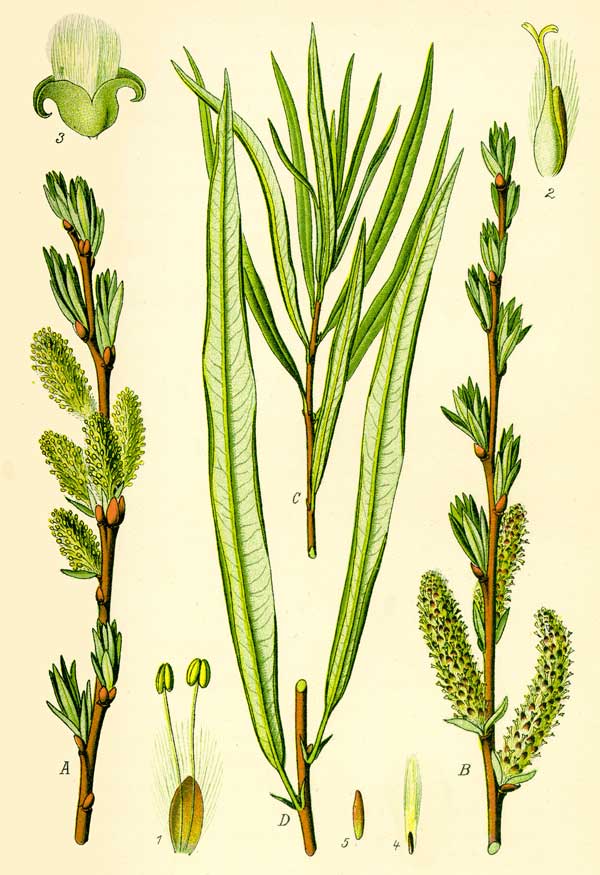
Salix viminalis, (*)
Classification System: APG IV
Superregnum: Eukaryota
Regnum: Plantae
Cladus: Angiosperms
Cladus: Eudicots
Cladus: Core eudicots
Cladus: Rosids
Cladus: Eurosids I
Ordo: Malpighiales
Familia: Salicaceae
Tribus: Saliceae
Genus: Salix
Subgenus: Salix subg. Vetrix
Sectio: S. sect. Viminales
Species: Salix viminalis
Varieties: S. v. var. gmelinii
Name
Salix viminalis L.
References
Linnaeus, C. 1753. Species Plantarum. Tomus II: 1021. Reference page.
USDA, ARS, Germplasm Resources Information Network. Salix viminalis in the Germplasm Resources Information Network (GRIN), U.S. Department of Agriculture Agricultural Research Service. Accessed: 07-Oct-06.
Vernacular names
български: Ракита
čeština: Vrba košíkářská
dansk: Bånd-Pil
Deutsch: Korbweide
English: Common Osier
español: Mimbre
eesti: Vitspaju
suomi: Koripaju
français: Saule des vanniers
galego: Vimieiro
italiano: Vinco
lietuvių: Žilvitinis karklas
Nederlands: Katwilg
norsk: Kurvpil
polski: Wierzba wiciowa
русский: Ива прутовидная
svenska: Korgvide
Türkçe: Sepetçi söğüdü
українська: Верба прутовидна
Salix viminalis, the basket willow,[1] common osier or osier, is a species of willow native to Europe, Western Asia, and the Himalayas.[2][3][4]
Description
Salix viminalis is a multistemmed shrub growing to between 3 and 6 m (9.8 and 19.7 ft) (rarely to 10 m (33 ft)) tall. It has long, erect, straight branches with greenish-grey bark. The leaves long and slender, 10–25 cm long but only 0.5–2 cm broad; they are dark green above, with a silky grey-haired underside. The flowers are catkins, produced in early spring before the leaves; they are dioecious, with male and female catkins on separate plants. The male catkins are yellow and oval-shaped; the female catkins are longer and more cylindrical; they mature in early summer when the fruit capsules split open to release the numerous minute seeds.[2][3]
Distribution and habitat
It is commonly found by streams and other wet places. The exact native range is uncertain due to extensive historical cultivation; it is certainly native from central Europe east to western Asia, but may also be native as far west as southeastern England. As a cultivated or naturalised plant, it is widespread throughout both Britain and Ireland, but only at lower altitudes. It is one of the least variable willows, but it will hybridise with several other species.[2][3]
Uses
Along with other related willows, the flexible twigs (called withies) are commonly used in basketry, giving rise to its alternative common name of "basket willow". Cultivation and use of the common osier was common in England in the 18th and 19th century, with osier beds lining many rivers and streams. In the Chilean village of Chimbarongo, it is used to fashion their renowned baskets.
Another increasing use is in energy forestry,[2] effluent treatment, in wastewater gardens,[5] and in cadmium phytoremediation for water purification.[4]
Salix viminalis is a known hyperaccumulator of cadmium, chromium, lead, mercury, petroleum hydrocarbons, organic solvents, MTBE, TCE and byproducts, selenium, silver, uranium, and zinc,[6][7] and as such is a prime candidate for phytoremediation. For more information, see the list of hyperaccumulators.
Ecology
Among the most common pathogens on S. viminalis are Melampsora spp. Female plants are more severely infected than male plants.[8][9]
References
"Salix viminalis". Natural Resources Conservation Service PLANTS Database. USDA. Retrieved 27 October 2015.
Meikle, R. D. (1984). Willows and Poplars of Great Britain and Ireland. BSBI Handbook No. 4. ISBN 0-901158-07-0.
Rushforth, K. (1999). Trees of Britain and Europe. Collins ISBN 0-00-220013-9.
Perttu, K. L. and Kowalik, P. J. (1997). Salix vegetation filters for purification of waters and soils. Biomass and Bioenergy, Volume 12, Issue 1, 1997, Pages 9-19. Elsevier Science Ltd.
"Wastewater Gardens® - Biosphere Foundation". Retrieved 18 September 2018.
Phytoremediation. By McCutcheon & Schnoor. 2003, New Jersey, John Wiley & Sons, page 19.
Enhancing Phytoextraction: The Effect of Chemical Soil Manipulation on Mobility, Plant Accumulation, and Leaching of Heavy Metals. Archived 2007-02-25 at the Wayback Machine By Ulrich Schmidt. In J. Environ. Qual. 32:1939-1954 (2003)
Moritz, Kim K.; Björkman, Christer; Parachnowitsch, Amy L.; Stenberg, Johan A. (2016-02-01). "Female Salix viminalis are more severely infected by Melampsora spp. but neither sex experiences associational effects". Ecology and Evolution. 6 (4): 1154–1162. doi:10.1002/ece3.1923. ISSN 2045-7758. PMC 4725332. PMID 26839685.
Åhman, Inger (1997). "Growth, herbivory and disease in relation to gender in Salix viminalis L.". Oecologia. 111 (1): 61–68. Bibcode:1997Oecol.111...61A. doi:10.1007/s004420050208. ISSN 0029-8549. PMID 28307506. S2CID 2962435.
Retrieved from "http://en.wikipedia.org/"
All text is available under the terms of the GNU Free Documentation License

